31.10.25
Isle of Raasay Distillery Visit & Interview
Hello everyone
Earlier this month I was going up to Skye and decided that would be a great opportunity to visit Isle of Raasay Distillery and 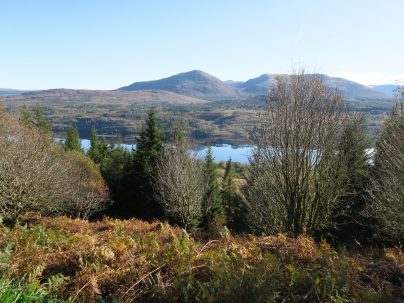 speak to some of the people who work there. I‘ve enjoyed and written about several of their whiskies and interviewed co-founder, Alasdair Day, in the past. For any of you thinking of heading up that way, I can say the drive from Glasgow to Skye on a bright autumn day was scenically spectacular with mountains reflected in the still waters of the lochs. Okay, it‘s not always like that though still dramatic under duller skies. You can also take a train to Mallaig and either a ferry from there to Skye or hire a car and drive up to the Skye Bridge to get over.
speak to some of the people who work there. I‘ve enjoyed and written about several of their whiskies and interviewed co-founder, Alasdair Day, in the past. For any of you thinking of heading up that way, I can say the drive from Glasgow to Skye on a bright autumn day was scenically spectacular with mountains reflected in the still waters of the lochs. Okay, it‘s not always like that though still dramatic under duller skies. You can also take a train to Mallaig and either a ferry from there to Skye or hire a car and drive up to the Skye Bridge to get over.

So how do you get to Raasay? The only route is by ferry from Sconser on Skye. The crossing takes 25 minutes but that includes the little ferry pulling away and docking again on Raasay. It does take cars and commercial vehicles. Clearly it has to in order to get supplies over to Raasay. During my visit it was a temporary boat with room for only ten or a dozen vehicles though the usual vessel takes about 20, I believe. If you prefer to leave your car on Skye there‘s parking at the little ferry port. Raasay itself isn‘t large and can be seen in a day if you start early enough but better to make it two days. There‘s a road on the island called Calum‘s road with a wonderful story behind it. Find out more at https://raasay.com/calums-road/ .

But back to the distillery. It‘s actually not far from the ferry but to get there is uphill so with a backpack or other luggage it‘s a slow walk or take your car. I‘d been promised an interview with four of the distillery team here and they are a delightfully young team. Great to see so many of them in the industry. Those I spoke to were Ross Gillies – Distillery Manager, Jane Crosbie – distillery operator, Chloe Leeman – Island Experience Manager and Ellen Mackay – Lead Tour Guide. Eight out of thirty in the full team are Raasay natives.
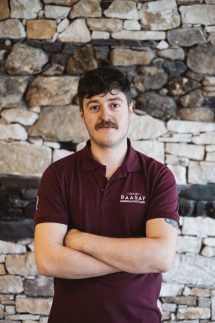 All have interesting backgrounds. Ross started off in civil engineering. Is it odd how quite a number of engineers become distillery managers? A Raasay native, he says he‘s here by pure chance. He came back to do a renewable energy micro hydro scheme job until it fell through and he joined the distilling team to have a job but it got into the blood. According to Ross, distillers were still needed and it was at a time when the pool of local talent had been exhausted. In terms of training it was all on the job experience spending a number of weeks or months at various parts of the process under more experienced distillers and he reckons you‘re never stopped learning. True!
All have interesting backgrounds. Ross started off in civil engineering. Is it odd how quite a number of engineers become distillery managers? A Raasay native, he says he‘s here by pure chance. He came back to do a renewable energy micro hydro scheme job until it fell through and he joined the distilling team to have a job but it got into the blood. According to Ross, distillers were still needed and it was at a time when the pool of local talent had been exhausted. In terms of training it was all on the job experience spending a number of weeks or months at various parts of the process under more experienced distillers and he reckons you‘re never stopped learning. True!
Jane did a degree in biotechnology which included a course on distilling. She reckons it was 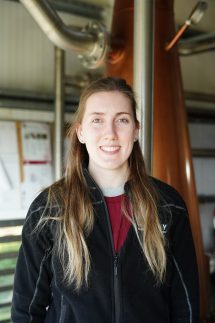 the only part of her degree that she really enjoyed – how biotech is applied in distilling. She got the bug for the industry from family visits to Islay. Contacts made on Islay gave her tips to get started in the industry but this was during Covid and the usual bar and tour guide routes were closed. She was recommended a few courses and went on to do the Institute of Brewers and Distillers foundation course which she finished just before starting her first job which was at Holyrood Distillery in Edinburgh where she worked for just over three years. Originally from Edinburgh, Jane moved to Raasay two years ago.
the only part of her degree that she really enjoyed – how biotech is applied in distilling. She got the bug for the industry from family visits to Islay. Contacts made on Islay gave her tips to get started in the industry but this was during Covid and the usual bar and tour guide routes were closed. She was recommended a few courses and went on to do the Institute of Brewers and Distillers foundation course which she finished just before starting her first job which was at Holyrood Distillery in Edinburgh where she worked for just over three years. Originally from Edinburgh, Jane moved to Raasay two years ago.
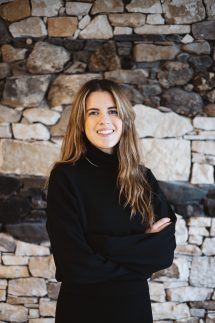 Chloe tells me she has always worked in hospitality and arrived on Raasay ten years ago to work at Raasay House, the only hotel on the island, for a summer season which then became several summer seasons. Hailing from Plymouth, he‘s the only non-Scot of my interviewees. She then met Ross, her partner and moved up here when the distillery opened. „And here I am still!“ That was in 2019 when she came to Raasay to help out with admin and she‘s “…done everything here now including operational side and logistics“ then moved over to be manager of the guest experience side. Chloe was very clear that everyone at the distillery mucks in to do a number of different tasks, especially as they were such a small team at the start. [They‘re on an island after all and all here to make a success of the distillery.] At first she and Craig, now a distiller here, were doing both operational and visit experience tasks. There was no bar or restaurant at that time. The house had visitors but nothing like the set-up they have now. Her Mum had worked at Raasay House so she cameup to there one summer to help then, „Met Ross and now I‘m trapped!“ she jokes.
Chloe tells me she has always worked in hospitality and arrived on Raasay ten years ago to work at Raasay House, the only hotel on the island, for a summer season which then became several summer seasons. Hailing from Plymouth, he‘s the only non-Scot of my interviewees. She then met Ross, her partner and moved up here when the distillery opened. „And here I am still!“ That was in 2019 when she came to Raasay to help out with admin and she‘s “…done everything here now including operational side and logistics“ then moved over to be manager of the guest experience side. Chloe was very clear that everyone at the distillery mucks in to do a number of different tasks, especially as they were such a small team at the start. [They‘re on an island after all and all here to make a success of the distillery.] At first she and Craig, now a distiller here, were doing both operational and visit experience tasks. There was no bar or restaurant at that time. The house had visitors but nothing like the set-up they have now. Her Mum had worked at Raasay House so she cameup to there one summer to help then, „Met Ross and now I‘m trapped!“ she jokes.
Ellen (pictured in a tour shot below) has been working as a tour guide for seven years (despite looking only about 20) which included some work while still a student. She‘s been on Raasay for about 18 months. Her previous work was at Glengoyne for five and a half years where her Mum worked too (these Mums do seem good at getting people into our industry). After school she wanted to study French and British Sign Language but thought she might not get in. She‘d always wanted to go to art school but high school guidance had said a job needed to make you money and they reckoned, „…art wasn‘t the one for that or that‘s what they tell you“, which was why she was going to pursue translating. Her mum suggested going to be an au pair so she worked as a nanny in Paris for two years. When she came back she needed a job and her Mum, who‘d worked at Glengoyne for 10 years suggested she come and give that a go. She was trying not to as Glengoyne is 30 minutes or so outside Glasgow but she did start there two weeks before she discovered she‘d got into art school. There she did a degree in fine art, specialising in photography. I asked later if she still gets to practise the photographic art and the answer is yes. It was part of the reason for coming to Raasay. Originally, though, her parents had come up to visit Raasay two years ago and they planted the seed by saying, „You might like it up here“ so it was first choice when looking at other distilleries.
Everyone who works at the distillery lives on Raasay. Despite its proximity to Skye there is only the ferry connection and it wouldn‘t be at all practical to live over there. I wondered what people did with their spare time as life isn‘t all about work. Chloe advised there are obviously „outdoorsy things“ and they all chip in „so swimming, lots of walking, climbing, „It‘s a good place to have hobbies“, walk the dogs“. Chloe reckons she always struggles with that question but says there is plenty to do and they clearly fill their time. Ellen says you don‘t have to go out to do stuff but she likes to spend time at home maybe cooking and baking. Her first winter there she reckoned there was an awful lot of spare time but now looks forward to winter so she has time to do more things she wants to do outside work. The team did also mention occasional beach bonfire get togethers. Chloe advises the guest experience side goes down to 4 days a week in November and December then is closed over January for R&R and they also employ a lot of seasonal staff. The core team stays over winter and then they recruit again for staff to work from April to September/October. Chloe goes on to say that work is pretty social too and the small team are all good friends. There are also other Raasay residents there year round. I‘d seen figures of 161 residents but Ross chimes in, „Officially, yes, but it‘s pushing 200 now though we need to wait for census figures for that“.
On the production side, only the water is local. The barley comes from Boort maltsters on the mainland so any peating will be done there too using peat from a north east Scotland location.They did grow barley on Raasay for three seasons, 2017-2019 but it didn‘t yield much. Ross says it was only in year 3 that they got a full mash from Raasay barley but it was exciting to do. There is peat on Raasay. However, there is no malting floor there. Ross says, „We have a bag of peat [just the one then!] and it is something that we‘d like to do one day.“ He mentions Stauning in Denmark tried this using local peat to malt barley in something like a shipping container but jokes that maybe it would be a fire hazard. Certainly, I‘m sure the Health & Safety authorities might have something to say.
I wondered how much is distilled each year and, given the whisky‘s popularity, it must be increasing. Jane advised that just before she started they increased to 12 shifts per week but it has recently reduced a little. As some places have stopped altogther, it‘s heartening that they‘re still operating. Jane continues to say they are limited by the capacity of their fermentation times. „Like most places, you can‘t distill anything not completely fermented and we don‘t run nightshifts so we can distil only so many days a week.“ They currently run 5 days a week Monday – Friday, operating two shifts a day. Tours still happen when distilling doesn‘t and there is a tasting experience as part of that.
I had a question about costs, knowing that on Islay, for example, things cost more to do and asked if Raasay had any more issues than other islands. Ross reckons when they need sub-contractors over then things like travel get expensive, located where they are. He compares it to some of the western isles which may be further out but, being larger, they have more of the relevant expertise on the island and that Raasay is just not quite far enough for that and not quite large enough. He tells me one of their distillers is incredibly good on maintenance and takes on a huge amount of work from trying to repair stills to a leaking vent in a caravan and all in between.
I asked if anything was harder in the distillers‘ jobs than maybe elsewhere. Jane volunteered networking as in being able to consult and speak to other people, not for career progression, but in terms of what they are doing to learn from them. When at Holyrood she‘d been involved in discussions with the Port of Leith distillers and, from Raasay, they‘ve been to Torabhaig on Skye to find out more about what they do.
One thing I ask all of my interviewees is what they like and don‘t like about their jobs if, indeed, there is anything. This crew 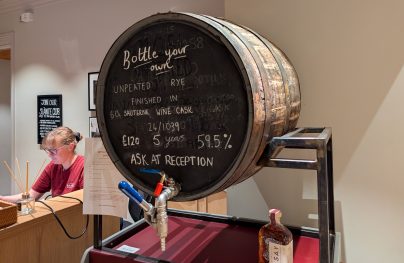 seem pretty contented. A bit of silence and then Chloe says the seasonal aspect is the thing she likes least and most. „You meet lots of really nice people – like this year‘s team have been the best we‘ve had but they don‘t stay forever. You build relationships and then they move on to the next thing.“ They don‘t always come back the next year? „No, so you have to recruit every year which is hard and takes a lot of time and retrain new people but you do get to meet a lot of nice people through doing that.“ Lovely thought. I‘d give a shout out here to Jamie (pictured here at Reception), a super girl from New Zealand who‘s been persuaded to stay on and experience a Scottish winter and seemed to be so competent at everything I saw her doing during the visit.
seem pretty contented. A bit of silence and then Chloe says the seasonal aspect is the thing she likes least and most. „You meet lots of really nice people – like this year‘s team have been the best we‘ve had but they don‘t stay forever. You build relationships and then they move on to the next thing.“ They don‘t always come back the next year? „No, so you have to recruit every year which is hard and takes a lot of time and retrain new people but you do get to meet a lot of nice people through doing that.“ Lovely thought. I‘d give a shout out here to Jamie (pictured here at Reception), a super girl from New Zealand who‘s been persuaded to stay on and experience a Scottish winter and seemed to be so competent at everything I saw her doing during the visit.
Jane doesn‘t like banding casks but admits that‘s a bit niche. She means banding casks together on a pallet, not any kind of coopering work. Ross agrees it‘s very fiddly and advises they‘ve never really had much problem with casks and not had to send many away. The few that have been a problem tend to become display casks like those outside the front door (shown here) and „People always want plant pots“. Ellen has a similar view to Chloe with „…amazing people who are really interested and who ask great questions“. She mentions a recent whisky festival in Belgium where people who had been on a tour with her came to say hello and a group of private cask owners who bought her a basket of beer and agrees it‘s lovely to have that kind of relationship. She admits, though, that some can be challenging and cites that there are still men out there who feel a need to nitpick over everything that she, as a woman in whisky, is saying and try to make out they know more when the whole point is that they‘re there to learn about Raasay or wherever. Been there myself and share the discomfort. All Raasay‘s tour guides are female apart from one. I met him during my visit and he‘s another Raasay multitasker.
want plant pots“. Ellen has a similar view to Chloe with „…amazing people who are really interested and who ask great questions“. She mentions a recent whisky festival in Belgium where people who had been on a tour with her came to say hello and a group of private cask owners who bought her a basket of beer and agrees it‘s lovely to have that kind of relationship. She admits, though, that some can be challenging and cites that there are still men out there who feel a need to nitpick over everything that she, as a woman in whisky, is saying and try to make out they know more when the whole point is that they‘re there to learn about Raasay or wherever. Been there myself and share the discomfort. All Raasay‘s tour guides are female apart from one. I met him during my visit and he‘s another Raasay multitasker.
Seems the main nationalities making the short trip over to Raasay are lots of Americans, French and Germans but particularly Americans who, I was told, are always so excited to be there. A few from all over the globe have managed to trace heritage to that part of the world. In 2024 just tour visitor numbers alone were about 10,000 which is an impressive number for such a small place. Numbers have gone down a little this year to about 8,000. I thought economic issues in many places may account 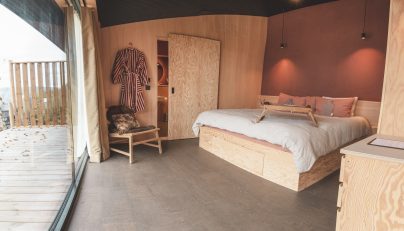 for that. Chloe agrees partially but thinks it‘s more related to Skye than a whisky industry visitor downturn as Skye is now an expensive place to stay and that while there are lots of day visitors, some accommodations and restaurants have been quieter this year. She points out that Raasay Distillery has almost doubled its rooms with the opening, just at my visit, of the new bothains – beautiful standalone rooms in the grounds that I can‘t
for that. Chloe agrees partially but thinks it‘s more related to Skye than a whisky industry visitor downturn as Skye is now an expensive place to stay and that while there are lots of day visitors, some accommodations and restaurants have been quieter this year. She points out that Raasay Distillery has almost doubled its rooms with the opening, just at my visit, of the new bothains – beautiful standalone rooms in the grounds that I can‘t  call cabins as they‘re far superior to that. They now have six rooms in the house and 5 bothains. They‘re going to stick with this number for a year or two to see if there‘s demand for more and they do have a phase 2 plan. Full extension right away would have meant feeding many more people daily instead of the current numbers. So far no extra housekeeping staff have been taken on. That mucking in thing again.
call cabins as they‘re far superior to that. They now have six rooms in the house and 5 bothains. They‘re going to stick with this number for a year or two to see if there‘s demand for more and they do have a phase 2 plan. Full extension right away would have meant feeding many more people daily instead of the current numbers. So far no extra housekeeping staff have been taken on. That mucking in thing again.
Chloe and Ellen don‘t find any job aspects particularly difficult. I was thinking of things like catering supplies. Ellen says they just want to get even better at their visit offering and Chloe adds that they learn to adapt and deal with such situations because of where they are. They just have to get on with things and solve problems. Tour groups are normally limited to about 12 though Ellen says they can be flexible but not overcrowd things so people can hear their guide speak and see all in the distillery. Again, Chloe mentions they want to be approachable and accessible as regards visits and not be ridiculously expensive so people can relax and have a good time. They recognise that many people are there for the island as much as the distillery. There speaks a good hospitality professional. [Reminds me of a wonderful guest house I used to use in Ay, in the Champagne region, which was very reasonably priced for superb quality rooms and breakfasts. It was taken over and poshed up in designer fashion by the champagne house next door and now costs three times as much to stay in it. I‘ve not been back.] Ellen adds that the team are good at giving visitors recommendations for things to do and see. She‘s even recommended engagement spots for people on occasion.
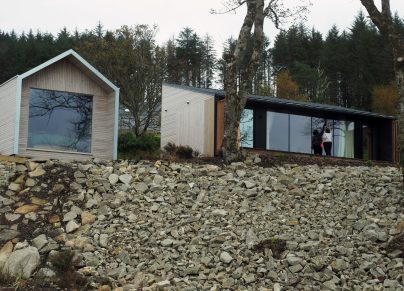 They do have an interesting and varied time here and the vibe of the place is very positive. As Chloe says, they have an all hands on deck approach across the whole team. She used the example that before the bothains were opened two of my interviewees pitched in to help clean them whereas some places maybe still have rather more fixed demarcation lines. People can now experience different departments to help out as necessary and not be in rigid job boxes which is a change Ellen has seen elsewhere.
They do have an interesting and varied time here and the vibe of the place is very positive. As Chloe says, they have an all hands on deck approach across the whole team. She used the example that before the bothains were opened two of my interviewees pitched in to help clean them whereas some places maybe still have rather more fixed demarcation lines. People can now experience different departments to help out as necessary and not be in rigid job boxes which is a change Ellen has seen elsewhere.
The rooms in the Borodale House at Raasay where the bar and 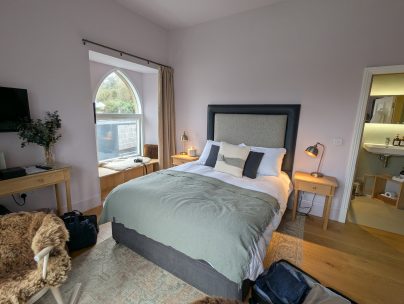 restaurant are also located, are lovely, homely and very comfortable. This pic shows Room 1, Aon. As seen above, I was also allowed to look in a few of the new bothains and they really are beautiful spaces. The largest one with the best view also has a sauna and plunge pool.
restaurant are also located, are lovely, homely and very comfortable. This pic shows Room 1, Aon. As seen above, I was also allowed to look in a few of the new bothains and they really are beautiful spaces. The largest one with the best view also has a sauna and plunge pool.
A little later I was part of one of Ellen‘s tours of the distillery which includes information about the gin they make there too and the separate equipment used for that. There is a water well on 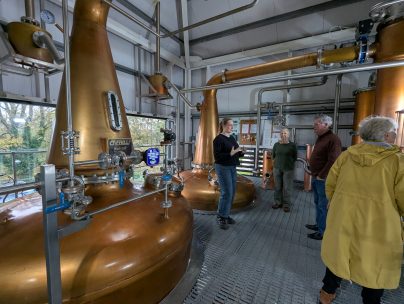 site and they make 50:50 peated and unpeated spirit for whisky maturation on a 3 month rotation, using all Scottish barley. There are 6 washbacks each of 5,000 litres and they use standard distiller‘s yeast though have also experimented with champagne yeast before. There is a 5-day fermentation and fill 3 casks per day, producing 200,000 litres of new make each year. The main cask types used are ex-rye casks leading to a peppery spiciness, ex-redwine casks and chinkapin oak which is not seasoned by any other liquid but does receive a level 4 char on the inside. Sherry casks are also used for their Dun Cana expression which staarts life in rye whisky casks for 3 years. All of their whiskies are still quite young but the novel cask usage means they are very tasty and a pleasure to drink while still youthful. A few other distillers have shown this can be the case too and that age isn‘t always a consideration. I could say much more but will let you visit and discover yourselves.
site and they make 50:50 peated and unpeated spirit for whisky maturation on a 3 month rotation, using all Scottish barley. There are 6 washbacks each of 5,000 litres and they use standard distiller‘s yeast though have also experimented with champagne yeast before. There is a 5-day fermentation and fill 3 casks per day, producing 200,000 litres of new make each year. The main cask types used are ex-rye casks leading to a peppery spiciness, ex-redwine casks and chinkapin oak which is not seasoned by any other liquid but does receive a level 4 char on the inside. Sherry casks are also used for their Dun Cana expression which staarts life in rye whisky casks for 3 years. All of their whiskies are still quite young but the novel cask usage means they are very tasty and a pleasure to drink while still youthful. A few other distillers have shown this can be the case too and that age isn‘t always a consideration. I could say much more but will let you visit and discover yourselves.
There was the tasting afterwards of two whiskies and the Isle of Raasay gin. Some of my fellow visitors hadn‘t tried their whisky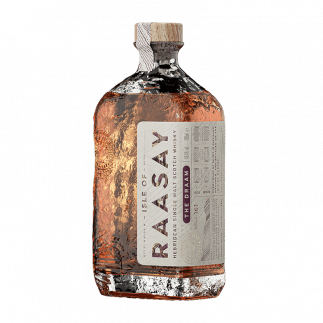 before and didn‘t think they liked peated whisky or gin but genuinely changed their minds here. Ellen is really very knowledgeable and does a cracking tour.
before and didn‘t think they liked peated whisky or gin but genuinely changed their minds here. Ellen is really very knowledgeable and does a cracking tour.
I was fortunate in being able to try some of the food while here and cannot fault the kitchen. Others eating were equally appreciative. Allergies like gluten and dairy can be accommodated. There‘s also a not too short and carefully chosen wine list which complements their menus. The bar offers a few signature cocktails and the package if staying over can include room, breakfast, tour and dinner as well as a welcome drink from a short selection. I should add here that my visit wasn‘t a PR freebie. I did pay for all I experienced. It was my decision to go over to see them from Skye to do the interview and see what they offer.
I thoroughly enjoyed my fairly short visit and meeting this excellent young and energetic team. They‘re a real asset to the place and my thanks to those who gave up some time to speak to me. If you haven‘t been or are just thinking about visiting, stop thinking and make reservations. There‘s loads more info on the website at www.raasaydistillery.com . HQ wouldn‘t give annual sales figures (not all companies will) but do say their whiskies can now be found in 51 markets round the globe. It‘s not just in big cities. I‘ve seen some in regional towns in Europe too so seek it out where ou are if not in the UK.
 Till next time, happy dramming and make some of that a Raasay.
Till next time, happy dramming and make some of that a Raasay.
Slainte mhath,
Caroline
Comments